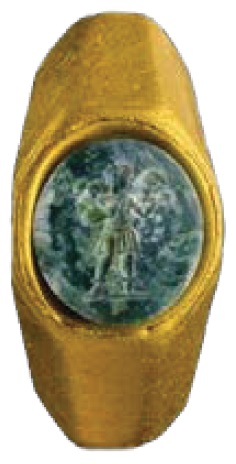The ring of the good shepherd
Publish date 02-06-2022

In December, thanks to the prospecting of divers belonging to the Maritime Unit of the Israel Antiquities Authority, the wrecks of two shipwrecked ships in the port of Caesarea, loaded with the goods they were carrying, were found.
The first wreck belongs to the Roman age (III century AD), when the city was an important trading point in the region.
In the first century, Caesarea was chosen by Herod as the site for the construction of a seaport and remained a nerve center throughout the Roman age until the Byzantine era. One of the many ships that circulated in the port was wrecked, so its wreck has reached the present day. Archaeologists found several artifacts in the ship's hold and objects belonging to the crew, such as gold and silver coins, a gem engraved with the image of a lyre, bronze bells, the figurine of an eagle, symbol of the Roman Empire, ceramic tableware and a very particular ring. The gold band is shaped in the shape of an octagon, while the bezel contains a green stone engraved with the image of a young man carrying a sheep on his shoulders. The image of the good shepherd is one of the first iconographies referring to the figure of Jesus, as the Gospel of John says (Jn 10:11): "I am the good shepherd".
The ring appears as one of the first representations of this type, also present in the Roman catacombs, and it is no coincidence that it comes from Caesarea. The city in fact hosted an important Christian community. In the Acts of the Apostles (Acts 10), for example, the episode of the centurion Cornelius, baptized by Peter, is recounted.
The second ship found in the port, on the other hand, is from the Mamluk period (14th century). In this period the importance of Caesarea had faded, in favor of other Mediterranean centers. The Mamluks also, not having a naval fleet, feared that the European powers would try to attack from the sea and destroyed many ports to avoid it. The wreck contained 500 silver coins. For now it is not possible to define the origin or the destination of the ship, but the archaeologists will continue the research and study of the materials as soon as the atmospheric conditions permit.
Agnese Picco
NP Febbraio 2022
To know more








